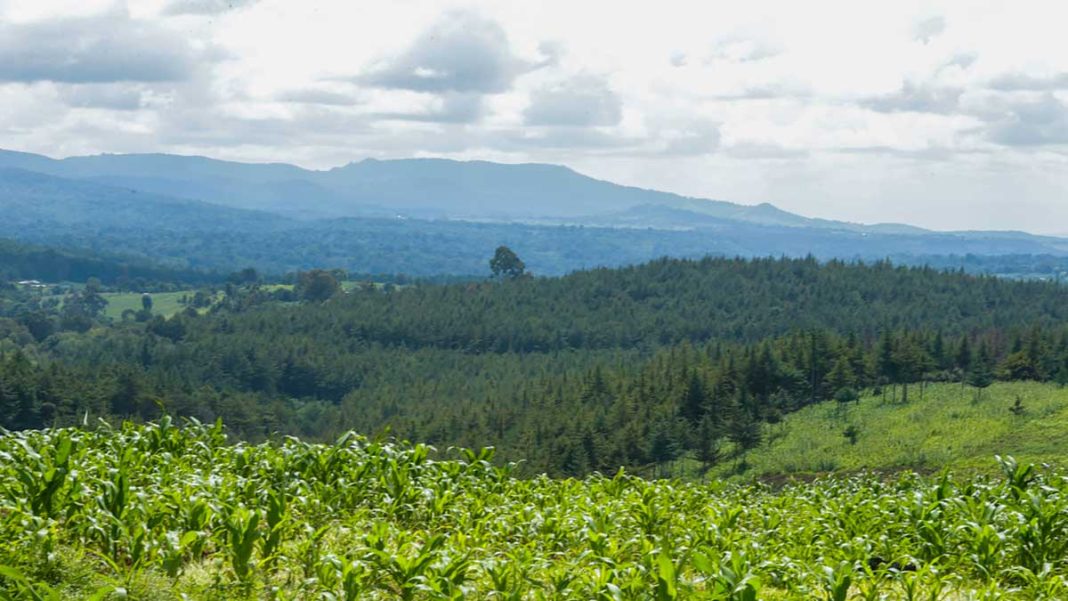The passion to spread the Message on the need to protect the Forests Forced this teacher from Sokonin Village in Eldama Ravine to Start a mock Radio Station- Cderz FM.
This is Wilson Barchiba and his very supportive Wife in their ”Studio”,and they are able to broad cast to an Audience within a 1KM Radius.
He has his own Forest where he seats down every Day to meditate, thinking about the Late Professor Wangari Maathai and what she wanted for the world’s future Generations. His biggest worry however is about the ongoing siltation in Lake Baringo and even Bogoria.
He is even worried about the future of Chemususu and the Kirandich Dams. When you bring him any topic about Bamboo planting,then you will became his Bosom Friend.
WHO ARE THE LEMBUS ?
The LEMBUS people are a sub-Tribe of the Tugen; and their ancestral Lands within Koibatek District cover the whole of Eldama Ravine Constituency; Lembus Mogotio, Lembus Kiptoim Ngubureti Locations in Mogotio Constituency.
Chief of Lembus, Cherono Chepchieng
At the advent of white colonialism and in the course of the colonial era the most fertile Lembus ancestral Lands were alienated for the use and benefit of the white settlers and the colonial Government.
The Lembus were elbowed out of Kiplombe and Koibatek hills/forests, the present day Sabatia Settlement Complex comprising of Perkera Settlement Scheme, Sabatia Settlement scheme, Ravine settlement scheme and Mumberes.
The LEMBUS were also moved out of Eldama Ravine Town, Londiani forest including present day Igure Farm. In effect the Lembus were disposed of their entire Lands south of Nakuru-Eldama Ravine Road from Molo River up to Kabimoi Trading centre and then downstream along Narosura River up to the place it meets Lembus, Saos Ward and all their Lands South West of Lembus Saos/Kipyas up to the whole of Lembus Forest.
Under the Notorious GROGAN CONCESSION, the whole of Lembus Forested area covering over 120,000 square miles were taken away from the Lembus and exploited from the EXCLUSION of the Lembus. This area extended from Timboroa/Torongo area to Londiani Forest, Maji Mazuri, Sabatia, Koibatek and Kiplombe in the West and Chemorgong in the North.
Thus during the most part of the colonial era the Lembus were confined to the marginal and dry Lowlands of the present day Lembus Mogotio. Lembus Kiptoim/Ngubureti, Lembus Kabimoi and Lembus Saos /Kipyas and to small open spaces in Lembus Forest in Torongo, Moringwa, Poror Kamngoech, Sigoro and Sirwa.
The land therefore left for use by the Lembus could not sustain their lifestyles based mainly on livestock rearing and keeping, this led to overstocking of the remaining lands which in turn led to force full and illegal confiscation of Lembus Livestock which had the TWIN PURPOSE of destocking the land and Forcing the Lembus to work as Labourers for the colonial settlers. The Lembus RESISTED this move and sent a war cry; LEMBUS MOPENDI KANDARAS , meaning “Lembus will not be labourers of the white settlers”. This was a call of Resistance to white occupation and domination.
The Lembus resisted white occupation and domination ,as early as 1932 the then Chief of Lembus, Cherono Chepchieng , complained to the Kenya Land Commission (Carter Land Commision) in 1932 that their land had been taken from the people of Lembus, first to be given to the Uasin Gishu maasai and then to the European Settlers and QUESTIONED how it had come about that the TUGEN could be denied access to their OWN LANDS.
He also complained that his father had lived beyond Kiplombe Hill, now well within the settled area and ended by saying that “the government had filled up the land with strangers “.
The Lembus were therefore a bitter and marginalised lot and it was therefore natural for most of their leaders to join KAU and later original KANU in the hope that come UHURU, the Lembus will recover their lost lands. However this was not to be , as immediately prior to and immediately after independence the then District
Leadership influenced the New Kenyan Government manipulated and DUPED the Lembus people who ended losing their Lands to yet another BREED of settlers mainly from central and other parts of Baringo District. The former Lembus Forest was also transferred to the local authority and later to the forest department under unclear circumstances and without consulting the Lembus people who were the right holders as per the CORYNDON AGREEMENT and the GROGAN CONCESSION.
When DAUDI CHEPTARUS, the New chief of the Lembus, who had taken over from chief JOEL CHEMIRMIR, who had in a huff, gone on early retirement, complained of NEO-COLONIZATION of the lembus lands, the said chief was immediately and unceremoniously relieved off his duties and a puppet chief installed.
However the Lembus people who are an accomodative and tolerant lot were prepared to work and cooperate with the new comers but UNKNOWN to them the new dorminant leadership from the NORTH were wary of the lembus and vigorously poisoned the minds of the non-lembus by portraying the lembus as an arrogant and unwelcoming community and the otherwise previous noble call for resistance against settler occupation “Lembus Mopendi Kandaras” was now used by the new district leadership to portray the Lembus as an arrogant and lazy lot who shied away from work.
The New district leadership after independence therefore created an environment which enabled the Lembus to be marginalized and impoverished as THEY at the same time embarked to EXPLOIT the resources of the Lembus in particular their LANDS, URBAN PLOTS and FORESTS. Also the Lembus were denied any meaningfull position in GOVERNMENT.

